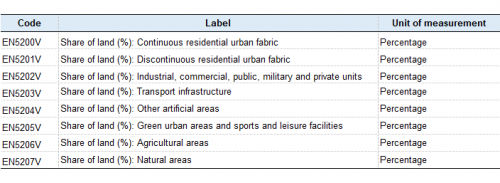City statistics – environment
Planned article update: October 2024
Highlights
This chapter of the City statistics manual provides the definitions that should be used for compiling data at city and functional urban area level in the following sub-domains: air quality, waste and land use. In order to ensure comparability across countries, the recommended concepts and definitions are in line with those used for compiling data at the upper geographical level. The chapter also contains links to methodology, publications and external information. Concepts and definitions regarding discontinued variables are not included in the chapter.
Full article
Air quality
All variables listed below are collected centrally. The source is the European Environmental Agency.
Variables:
Notes: See ozone, nitrogen dioxide, particulate matter definitions for the above table.
Waste management
Variables:
The data only refer to the waste flows collected under the responsibility of the local administration including waste collected on behalf of the local authority by private companies or regional associations founded for that purpose.
Municipal waste (EN4008V) according to the definition in the OECD/Eurostat questionnaire on waste includes chapters 20 and 15.1 of the List of Waste (LoW). These cover household and similar wastes, also:
- bulky waste (e.g. white goods, old furniture, mattresses); and
- garden waste, leaves, grass clippings, street sweepings, the content of litter containers, and market cleansing waste, if managed as waste.
It includes waste originating from:
- households,
- commerce and trade, small businesses, office buildings and institutions (schools, hospitals, government buildings).
It also includes:
- waste from selected municipal services, i.e. waste from park and garden maintenance, waste from street cleaning services (street sweepings, the content of litter containers, market cleansing waste), if managed as waste.
It includes collected waste from these sources:
- door-to-door through traditional collection (mixed household waste), and
- fractions collected separately for recovery operations (through door-to-door collection and/or through voluntary deposits).
For the purpose of this questionnaire, municipal waste refers to waste defined as above, collected by, or on behalf of, municipalities.
The definition also includes waste from the same sources and similar in nature and composition which:
- are collected directly by the private sector (business or private non-profit institutions) not on behalf of municipalities (mainly separate collection for recovery purposes),
- originate from rural areas not served by a regular waste service, even if they are disposed of by the generator.
The definition excludes:
- waste from municipal sewage network and treatment,
- municipal construction and demolition waste.
Chapter 20 of the LoW contains a number of waste collected separately. However, packaging waste is excluded from this chapter and is instead classified under chapter 15. Several countries, organising their data collection on the basis of the List of Waste, are known to exclude packaging waste generated by households from municipal waste statistics since it is not classified under chapter 20. These countries underestimate their municipal waste generation, and their efforts in the recycling of waste generated by households are not fully taken into account in their reporting on municipal waste.
Land use
All variables listed below are collected centrally based on Copernicus Urban Atlas data.
Variables:
Direct access to
See also
Database
- City statistics (urb), see:
- Cities and greater cities (urb_cgc)
- Functional urban areas (urb_luz)
- Perception survey results (urb_percep)
- Waste generation and treatment (env_wasgt)
- Waste streams (env_wasst)
Dedicated section
Publications
Visualisations
External links
This article forms part of Eurostat’s City statistics manual.



